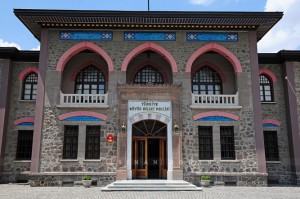
SENA KAYASÜ (ARCH/IV)
sena.kayasu@ug.bilkent.edu.tr
As an architecture student living in Ankara, it’s not surprising that I’m expected to know about the various stages of design and building in this city. We’ve gone over it in multiple courses, ranging from design to history.
We have finally come to the point where we learn to repair and not just to build; i.e., fourth-year students have to take a course about the conservation of historical environments. Of course, we’re looking at “historical Ankara” again. Quite logical, but I thought that this time I had a duty to comment on it a little bit.
First off, what is meant by “historical Ankara” is not equivalent to the “old town” in a European city. It does not describe an urban fabric that stretches back centuries and gives us an idea about how people used to live. It’s rather the combination of sporadic ancient structures that have (barely) managed to survive the ever-looming threat of looting and demolition, and the buildings of the Republic. So anything that’s more than 90 years old stands isolated as one of the very few historical attractions of Ankara.
This is exemplified by the citadel. The Ankara citadel is representative—through visible repairs and inscriptions—of the countless peoples that invaded and/or occupied it, including Greeks, Romans, Persians and Seljuks. This is because Ankara was not a small town stranded in the middle of the arid Anatolian plain. It was, at least occasionally, a booming trade center on the Silk Road. For this reason, the citadel remained in use and was conserved. In fact, it’s the best-preserved part of the city, where the remains of hans and kervansarays were visible enough that they could be restored and reinstated such that they are once again in use today. In fact, there are people who live and work in the citadel, as there should always be. Their houses are “traditional Ankara houses.” The trouble is, part of the tradition is that they be built of wood.
 Wood burns. Fast. The entire residential district of Hamamönü burned to the ground in the 19th century. It had been abandoned and all but torn down, until a large-scale restoration project was undertaken in the new millennium to restore the buildings and give an idea of how people in Ankara adapted their dwellings to suit the climate and their lifestyle. No house, not even in the citadel, predates the 19th century. Because of wood.
Wood burns. Fast. The entire residential district of Hamamönü burned to the ground in the 19th century. It had been abandoned and all but torn down, until a large-scale restoration project was undertaken in the new millennium to restore the buildings and give an idea of how people in Ankara adapted their dwellings to suit the climate and their lifestyle. No house, not even in the citadel, predates the 19th century. Because of wood.
The reconstruction project was well-intentioned and well-supported by the standards of this country, but it wasn’t necessarily successful. That is to say, it did not stay true to the facts. There are wide roads, planted with trees, as well as large, ornate windows on the bottom floors, neither of which are in the historic record for Ankara. The goal must have been to keep warm in the icy, windy Ankara winters. You can see the division clearly in a typical Ankara house: the bottom floor has thicker walls and smaller windows, and is mostly used in the winter. The upper floor has large windows and lighter walls—“jumbas”—that project out of the building to receive sunlight and allow access to the outdoors. The rooms up there were more often used in the summer, since with our dry climate we get the worst of both seasons. Makes sense.
After these—and the Roman baths, of course, which have been pillaged and uprooted to create more space on very valuable real estate (technically it’s a heritage site, but who cares)—there are the Republic-era buildings, such as the First and Second Parliament buildings.
The newly founded Turkish Republic needed a unifying cultural identity that distinguished itself from all things Ottoman. So its architects went back to their roots. They looked at “Anatolian houses.” These are characterized by wide eaves (extensions of the roof) and the use of local materials: timber and stone. This same style is evident in the older buildings of government ministries as well as Ankara and Gazi universities.
Another structure holding an important place in Ankara’s history is the railway station or “Gar.” The entire master plan of Ankara was designed, in 1924, with the main axis starting at the Gar to give people an easier access route into the city (since everyone traveled by train back then). The airport was built behind the Gar on the same axis. Güven Park was placed near it to give people a respite from the bustle of the emerging city center. The Parliament and ministries were centered around this single-platform, miniscule train station.
That first version of the railway station was in fact built in 1892, long before the Republic. But the railway system, and other innovations, were being implemented as signs of something new. It was in those years that the Ottomans began to reconsider architecture and attempt to develop a style befitting a transforming country. This was the era of Sirkeci Garı in İstanbul. It was also the beginning of the period when Mimar Kemalettin thrived (if you don’t know who that is, you can find him on the back of your 20 TL banknote). The architecture then morphed into that which created the Parliament building, and was again transformed after the first decade of the Republic when foreign architects were brought in to produce structures such as the Gar.
One of the virtues of Ankara, despite the city’s seeming ordinariness, is that it contains marks of everything that the Republic has gone through. It shows us the five styles of Republican architecture, each of which lasted a decade—a succession that ended in the ’60s, when all the rules broke down. It would be quite enlightening to take a Sunday stroll through Old Ankara to see how things changed.
